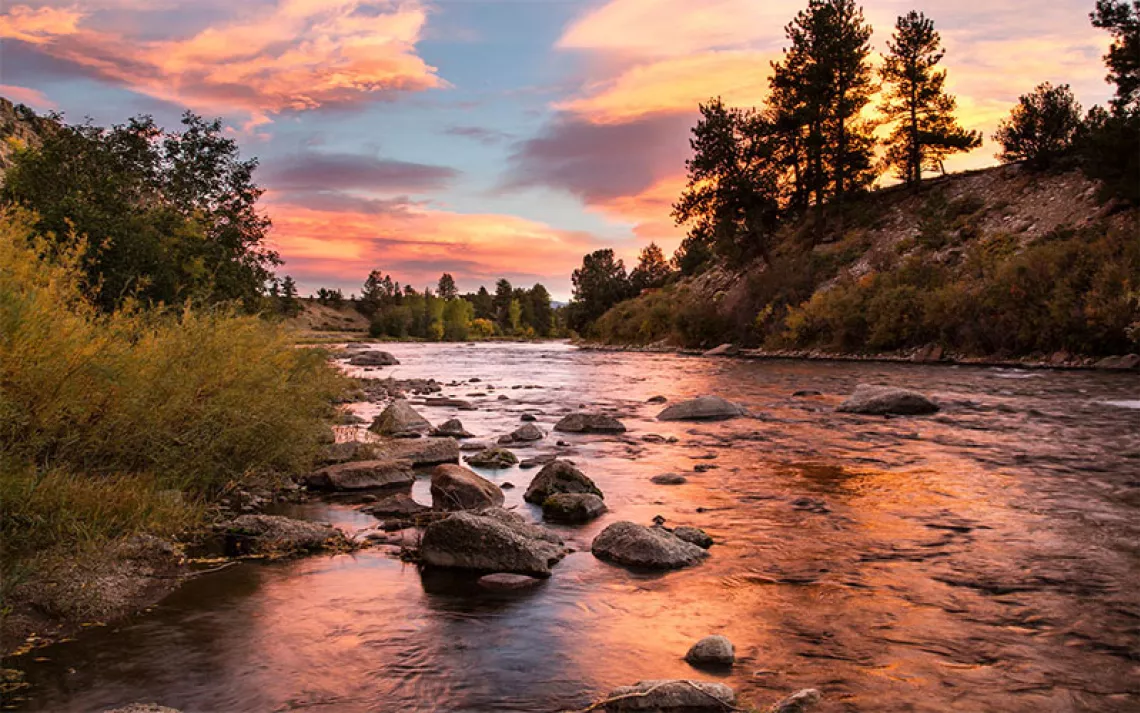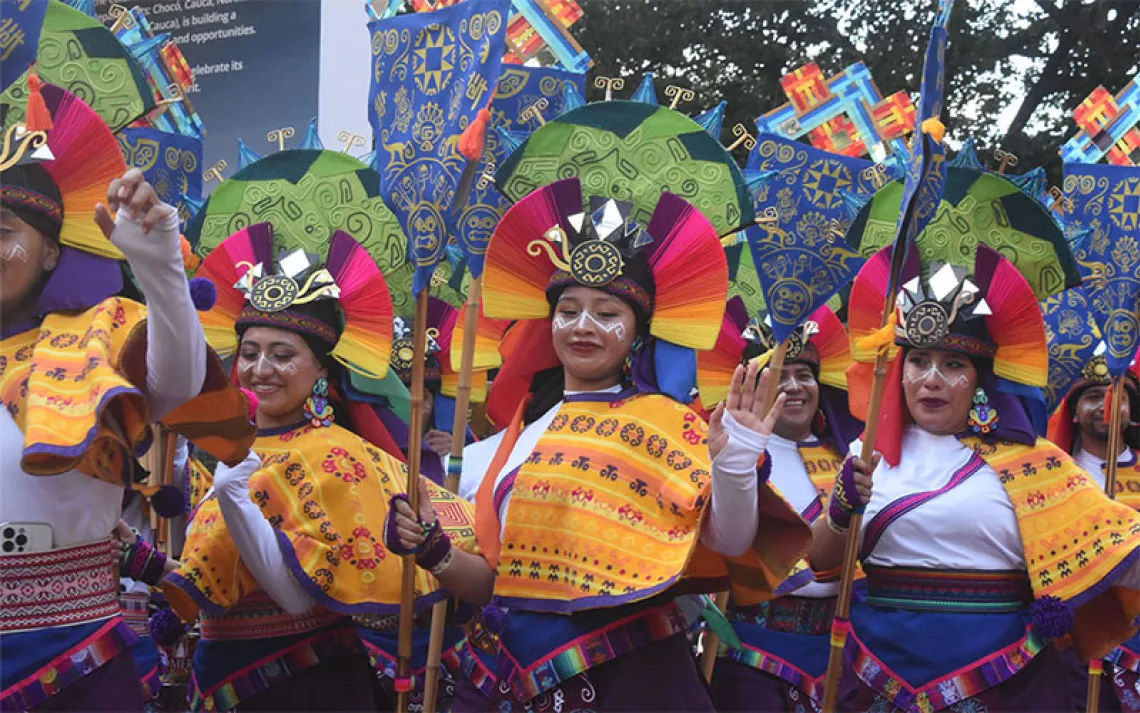Supreme Court Rules Against Navajo Nation in Colorado River Case
155 years after signing a treaty with the US government, tribe still unable to quantify water rights

The Colorado River in the Upper Colorado River Basin in Lees Ferry, Arizona, in May 2021. The Supreme Court ruled on June 22, 2023, that the federal government is not obligated to help the Navajo Nation access water from the Colorado River. | Photo by Ross D. Franklin, AP File
The effort by Native American nations to secure the basic resources needed for their well-being suffered a setback this week when the US Supreme Court ruled June 22 that the federal government is not obligated to help the Navajo Nation access water from the Colorado River.
In a 5 to 4 decision, the high court justices rejected the Navajo Nation’s arguments that, under the 1868 treaty between the US government and the Navajo Nation, the federal government has a responsibility to assist the tribe in securing its water rights. Writing for the majority, Justice Brett Kavanaugh argued, “It is unsurprising that a treaty enacted in 1868 did not provide for all of the Navajo’s current water needs 155 years later.” Kavanaugh also stated that in 1868 the Navajo (or the Diné, as Navajo refer to themselves) would not have understood the treaty to mean that the United States must take affirmative steps to secure water for the tribe.
In a separate concurrence, Justice Clarence Thomas questioned the United States’ “trust obligations” to tribal nations, which he believes lack constitutional support. Thomas’s stance reflects what some federal Indian law experts feared could have been the worst outcome for tribes—dismantling the 1908 Winters Act, which established that all federally recognized tribes have rights to the water necessary to live on the reservations that the United States established for them.
The case, Interior v. Navajo Nation, began in 2003, when the Navajo Nation sued the federal government for falling short of its obligations to help the tribe quantify its water rights on the Colorado River. The tribe cited a breach of trust under the Winters Act as the basis for its claim. Eighteen years later, the US Court of Appeals for the Ninth Circuit sided with the Navajo Nation. In March 2022, the Department of the Interior appealed the ruling to the Supreme Court, which this week overruled the appellate court decision.
In response to the ruling, Navajo Nation president Buu Nygren issued a statement that expressed disappointment but said the nation is “encouraged that the ruling was 5–4. It is reassuring that four justices understood our case and arguments.”
Justice Neil Gorsuch, perhaps the most eloquent voice for Native sovereignty in the court’s history, tried to make the case for Indigenous rights. In a dissent signed by the court’s three most liberal justices, Gorsuch cited the 1868 treaty and said the provision to make the Navajo Reservation a “permanent home” implies providing water rights. Gorsuch describes the Navajo’s request as simple: to quantify the Navajo Nation’s mainstem Colorado River water rights held in trust by the US government. He called out the United States for resisting these efforts: “The Government owes the tribe at least that much.”
Gorsuch criticized Kavanaugh’s remarks about the Navajo Nation misunderstanding the original treaty. “If two parties understand a key provision differently, the controlling meaning is the one held by the party that could not have anticipated the different meaning attached by the other.” The United States orchestrated the treaty process under its understood political and cultural constructs. The treaty, written in English, was translated to Diné through a Spanish interpreter. According to the Diné Hataałii Association, an organization of more than 200 Diné medicine men and women, the tribe fully understood the issue of water rights when the treaty was signed. Under a traditional Diné law interpretation of the original treaty, the United States has an affirmative duty to assess the Navajo Nation’s water needs and develop a plan to meet them, the association believes.
The court’s decision arrives during the Colorado River Basin’s worst drought in 1,200 years, with all stakeholders in the region—tribal, state, and local governments and private landowners—concerned about water security. But to understand the importance of Interior v. Navajo Nation requires 155 years of time travel, to the year 1868, when the original treaty was agreed upon.
The 1868 treaty, and the purpose of the reservation, was agreed to under duress for the Navajo—after their release from captivity. In 1863, 10,000 Diné were forcibly marched some 400 miles from their homes to Bosque Redondo, an internment camp in New Mexico. During this genocidal effort to eradicate Diné culture and language, thousands of Diné died of dysentery, exposure, and starvation, or were shot by soldiers. The Diné were promised a return to their traditional lands, where a reservation would be their permanent home.
Today, the Navajo Nation spans 17 million acres across Arizona, New Mexico, and Utah. Finite ground water is the primary water source for the Navajo Nation, which receives only 5 to 25 inches of precipitation annually. An estimated 40 percent of the Navajo Nation’s residents do not have access to running water. The Colorado River flows along the Navajo Nation’s northwest boundary, and all of the nation falls within the Colorado River Basin. Yet almost none of the tribe’s water is drawn from the Colorado River. While the Navajo Nation has very senior water rights, the amount of water it holds claim to remains unknown.
The arguments on both sides of this week’s decision reveal sharp divisions within the Supreme Court’s own understanding of US history, Indian treaties, tribal needs, and trust obligations. According to Justice Gorsuch, the majority decision gets hung up on the wrong legal framework—that a win for the Navajo Nation means the government will be required to build water infrastructure for the tribe. But this position was not included in the Navajo Nation’s original argument. The majority decision misses the main point entirely: to determine the amount of water required to make the Navajo Nation a permanent home. “If it turns out the United States has misappropriated those water rights,” Gorsuch wrote, “the Tribe wants the federal government to come up with a plan to set things right.” Which is still not the same as building anything.
For its part, the federal government—in this case, the Interior Department—expressed a concern that a win for the Navajo Nation would inspire lawsuits from other tribes. To date, the United States has broken more than 370 treaties with tribal nations. Meanwhile, the states of Arizona, Nevada, and Colorado, which draw water from the Colorado River, feared that a Navajo Nation victory would undermine the current Colorado River agreements and management. Until the Navajo Nation’s water rights (which are senior to states’ rights) are determined, other governments are using the tribe’s water.
Where can the Navajo Nation go from here?
According to law professor Heather Tanana, an enrolled member of the Navajo Nation, the burden of resolving this now falls upon the Navajo Nation. “Federal involvement would have made this more effective and efficient for all parties,” she told Sierra. Tanana was disappointed by the outcome, especially on the heels of this month’s Haaland v. Brackeen case, which upheld the Indian Child Welfare Act. Still, she is not surprised at the outcome, given the current court and the United States’ track record with tribal rights.
The Navajo Nation’s remaining option is to intervene in cases that affect their claimed water interests. But the tribe’s previous requests to do so have been denied. It’s a scenario that Gorsuch equated to waiting in line at the Department of Motor Vehicles since Elvis was alive: “The Navajo have waited patiently for someone, anyone, to help them, only to be told (repeatedly) that they have been standing in the wrong line and must try another.”
Gorsuch’s dissenting comments bring hope to Tanana. “Gorsuch is the RBG of tribal rights,” she said, referring to the late justice Ruth Bader Ginsburg, who was a champion of gender equality under the law. In this week’s dissent, Gorsuch’s closing remarks emphasized the importance of Navajo Nation sovereignty in the steps ahead. “As they did at Bosque Redondo, they must again fight for themselves to secure their homeland and all that must necessarily come with it. Perhaps here, as there, some measure of justice will prevail in the end.”
Navajo Nation president Nygren remains focused on securing quantified water rights in Arizona with a newly established water rights negotiation team. “My job as the President of the Navajo Nation is to represent and protect the Navajo people, our land, and our future. The only way to do that is with secure, quantified water rights to the Lower Basin of the Colorado River,” Nygren said in a statement. “I am confident that we will be able to achieve a settlement promptly and ensure the health and safety of my people. And in addition, the health and productivity of the entire Colorado River Basin, which serves up to thirty tribes and tens of millions of people who have come to rely on the Colorado River.”
 The Magazine of The Sierra Club
The Magazine of The Sierra Club



